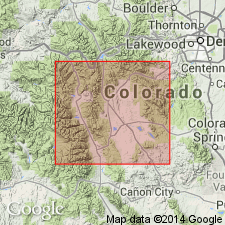
- Usage in publication:
-
- Dyer dolomite member*
- Modifications:
-
- Named
- Dominant lithology:
-
- Limestone
- AAPG geologic province:
-
- Eagle basin
- South Park basin
Summary:
Named as upper member of Chaffee formation for typical exposures on West Dyer and Dyer Mountains, 5 mi east of Leadville, Lake Co, CO in Eagle basin and Park Co in South Park basin. No type locality designated. Composed of 75 ft of light-gray, sugary, dolomitic limestone, with a few dark-gray and ocher-colored beds. Was formerly included in the Leadville limestone (called "Blue" limestone by miners). Overlies Parting member of Chaffee; underlies Leadville. Is of Devonian age.
Source: GNU records (USGS DDS-6; Denver GNULEX).
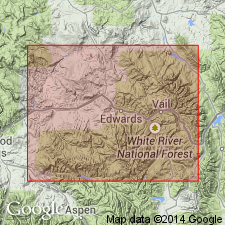
- Usage in publication:
-
- Dyer dolomite member*
- Modifications:
-
- Revised
- Areal extent
- AAPG geologic province:
-
- Eagle basin
Summary:
Pg. 152 (table 1), 174-177. Dyer dolomite member of Chaffee formation. Described in Pando area where it is 73 to 80 feet thick; overlies Parting quartzite member and uncomformably underlies Gilman sandstone member (new) of Leadville dolomite. [Age is Late Devonian.]
[Typically exposed on West Dyer and Dyer Mountains, 5 mi east of Leadville, Eagle Co., central CO.]
Source: US geologic names lexicon (USGS Bull. 1200, p. 1190).
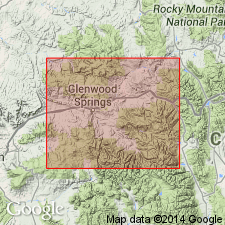
- Usage in publication:
-
- Dyer Formation
- Modifications:
-
- Revised
- Redescribed
- Overview
- Dominant lithology:
-
- Dolomite
- Limestone
- AAPG geologic province:
-
- Piceance basin
- Green River basin
- Eagle basin
Summary:
Raised in rank and assigned as upper of two formations of Chaffee Group (rank raised). Divided into two newly named members (ascending): Broken Rib and Coffee Pot Members. Dyer occurs in Rio Blanco and Garfield Cos, Piceance basin; Routt Co, Greater Green River basin; and Eagle and Pitkin Cos, Eagle basin. Consists of dolomitic limestone (Broken Rib) and dolomite (Coffee Pot). Isopach maps of members show that Broken Rib ranges up to 80 ft thick in northwest part of study area and Coffee Pot ranges up to 120 ft thick in southwest part of area; members thin to east and northeast. Conformably overlies Parting Formation (rank raised); disconformably underlies Gilman Sandstone Member of Leadville Formation. Measured section; fence diagram. Assigned latest Late Devonian age though upper part of Coffee Pot may be Kinderhookian age.
Source: GNU records (USGS DDS-6; Denver GNULEX).
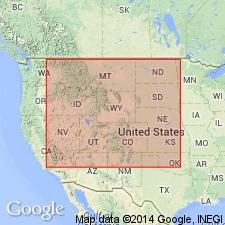
- Usage in publication:
-
- Dyer Dolomite*
- Modifications:
-
- Biostratigraphic dating
- AAPG geologic province:
-
- Eagle basin
- Piceance basin
Summary:
In a section on the Eagle-Garfield Co line just east of Glenwood Canyon, CO in the Eagle and Piceance basins, the Dyer is 46 m thick, lies above the Parting Formation, and below the Gilman Sandstone. The Coffee Pot Member at the base [should be top] is in the Polygnathoid-Pelekysgnathoid biofacies, or upper part of the Upper POLYGNATHUS STYRIACUS conodont zone. Broken Rib Member at the top [should be base] is in the Lower BISPATHODUS COSTATUS conodont zone and in an unzoned interval. At this locality, the Dyer is of Late Devonian, Famennian age. Lithofacies map.
Source: GNU records (USGS DDS-6; Denver GNULEX).
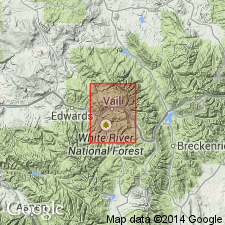
- Usage in publication:
-
- Dyer Dolomite*
- Modifications:
-
- Overview
- Age modified
- Redescribed
- Dominant lithology:
-
- Dolomite
- AAPG geologic province:
-
- Eagle basin
Summary:
Is middle of three formations of Chaffee Group (revised). Consists almost entirely of dolomite within Minturn quad, Eagle and Summit Cos, CO, Eagle basin. Dolomite is gray to black, much of it finely laminated in shades of gray, and is characteristically fine grained, thin-bedded, and breaks into small, sharp hackly fragments. Laminations are wavy and have been interpreted as stromatolitic in origin by Campbell (1970). Lower half to two-thirds weathers light buff or yellowish gray; upper part weathers dark brown to bluish gray. Within canyon of Eagle River and in adjoining mines, Dyer contains several distinctive marker beds. Except where channels have been cut into unit, Dyer is uniformly 75-80 ft thick in most of area near Gilman and southward to Leadville. Conformably overlies Parting Formation (redescribed) of Chaffee; unconformably underlies Gilman Sandstone (revised) of Chaffee. Measured section; geologic map; stratigraphic chart. Others have reported Upper Devonian brachiopods elsewhere in lower part of unit. Upper part of Dyer is poorly fossiliferous and its age is not well established. Other have reported fossil coral in upper part of Dyer suggesting Early Mississippian age; Dyer passes westward into Lower Mississippian limestones in subsurface; and Early Mississippian endothyrid Foraminifera occur in upper part of correlative Ouray Limestone. Based on the above, Dyer considered Late Devonian and Early Mississippian? age.
Source: GNU records (USGS DDS-6; Denver GNULEX).
For more information, please contact Nancy Stamm, Geologic Names Committee Secretary.
Asterisk (*) indicates published by U.S. Geological Survey authors.
"No current usage" (†) implies that a name has been abandoned or has fallen into disuse. Former usage and, if known, replacement name given in parentheses ( ).
Slash (/) indicates name conflicts with nomenclatural guidelines (CSN, 1933; ACSN, 1961, 1970; NACSN, 1983, 2005, 2021). May be explained within brackets ([ ]).

